It had been three long years since I’d gotten a moose, and the freezer was clatteringly empty. We hadn’t done so well with fishing this year, either, so it seemed like a good time to shake things up. As I hopped in the truck to go, I didn’t realize that someone I didn’t know was just down the road brandishing a gun and threatening to shoot police officers. This guy’s escapades caused one of the oddest beginnings to a hunting trip I’ve ever had.
The trip itself had been weeks in the planning, with a couple of hectic days of packing and preparing before the actual journey began. The plan was for three of us to drive up to the North Slope and fly out of the Happy Valley airstrip to be dropped off in the foothills of the Brooks Range on the Ivishak River to float out on inflatable boats and preferably find some caribou to bring home with us. On the Sunday before our departure, I’d been at the rifle range making sure my .30-06 was shooting straight and, back home, I was rustling up odds and ends, making a big pile of stuff that needed to be packed or set aside. This was one of the most complicated packing efforts I’ve undertaken – more complex I think than any fieldwork I’ve ever done. It had snowed on the North Slope the week before, so we were packing for a float trip that included hunting and camping in snow after a long drive into remote country. I wound up with a bigger pile than I would have liked, but there was nothing in it of much weight that would have made the pile substantially smaller. The night before leaving, I put everything needing it into dry bags and loaded the truck for an early morning departure.
And I did leave early – so early that I would have made it to our meeting point with 15-20 minutes to spare if not for the fact that the police had closed the roads around the armed standoff. So, instead of a quick 15-minute drive, it took me 50 minutes going on a very roundabout route to pick up Kevin May, our trip leader, before heading up to Fox to meet Ken Severin. At least the scenery was pleasant. It was a gorgeous fall morning, and a big full moon was slowly setting. Ken and I were novices to this way of hunting and were happy that Kevin May was willing to show us how it was done. Two of us drove because I had a day less to spend away than Kevin and Ken. From Fox we drove for 10 hours north over the Brooks Range to Happy Valley, stopping in Coldfoot for gas. Along the way we learned a little more on the radio about the armed standoff that we’d thankfully left behind.
At Happy Valley we met with Bob, our pilot, of 70 North. He did not have good news: Last week’s snow had pushed the caribou from the Ivishak drainage south across the Brooks Range. We could float, but we were unlikely to be bringing any hairy friends home for dinner. After putting a tentative alternate plan together, we weighed out all of our gear into three piles that each, with their human, weighed less than 670 lbs, the Helio Courier’s limit on this airstrip. Then, after some dinner and conversation, we went to sleep in one of the nice bunkhouse rooms that 70 North maintains at Happy Valley. They were not heated so late in the year, but they were very comfortable nonetheless; we were prepared for much worse, and a cold, Arctic Ocean fog had rolled in after sunset.
The next day, once the fog had cleared in late morning, Bob and Kevin May flew out to the west to scout for a substitute destination. Bob had seen some caribou out that way after the Ivishak animals had left, which sounded promising. As we waited in Happy Valley, Ken and I were treated to an amazing sun halo display. We commonly see sun dogs in Alaska, but this was not only a full 22-degree halo, it also had interesting arabesques of light coming off of it. While we were there, we also noticed a surprising number of high-altitude jet contrails going east-to-west well north of us. Bob eventually returned without Kevin, who had been dropped off with all of his gear on the Itkillik River. In quick succession, Bob next took me and Ken out there, too. It was about a half-hour flight over beautiful open tundra. The snow in the lowlands had melted off, but to our south the Brooks Range was shining brightly in the sun.
On the temporary landing strip gravel bar, Kevin and I put our boats together and got ready to float, so when Ken arrived it was short work to get all three of us into the water. As we’d waited on the bar for that last flight to arrive, a bull musk ox had come slowly toward us along the river from the south. The approaching airplane made him change his mind, and he turned away and began crossing the river to head back south. As the plane came in to land on the bar, the bull – midriver – swung around into a fighting stance. Then he did it again a second time when the plane taxied back to our pile of gear. That guy wasn’t going to take guff from anyone.
Once inflated and loaded, our three boats were light and elegant on the water. The oar rigs made handling them solo much easier than paddling. We floated downriver to the north for a little while until we found a good bar to camp on that had access to a nearby bluff so we could glass for animals. It was late, so we pitched camp and settled in for the night. While we refer to these as gravel bars, the gravel is not the sort of pea-sized gravel that one commonly encounters, but rather golfball- to softball-sized gravel (and larger). Camping on the bars required me, with my rather thin sleeping pad, to choose my tent site very carefully. Kevin had brought a large teepee tent in which we could all sit out of the cool breeze (he also had a very thick sleeping pad well suited for these bars). His tent proved to be a great place to gather for coffee in the morning and dinner in the evening.
We spent the next day on the bluff with a cold wind at our backs, looking for caribou. While we saw a lot of Willow Ptarmigan and Canada Geese out feeding on berries on the tundra, four-legged creatures were scarce. I took a long, looping walk out across some of the rough and spongy tundra behind us, but there was no game there, either. Back at a different spot on the bluff, I watched a red fox come by just below me and stop in surprise and confusion when he smelled me. My camouflage was working well, though, for although he spent awhile looking, he did not see me. Later, when we were all together again at one spot on the bluff, a Northern Shrike flew by but stopped and hovered and looked at the three of us carefully before continuing on. A very distant moose could be seen to the south, but that was all the big-game action for the day.
We didn’t have to get up at dawn the next morning; the fog took awhile to clear. So we had time to doze and drink some coffee before walking out to the bluff to begin the day’s work of glassing the vast country for caribou. Binoculars are essential for this kind of hunting in wide, open country, and gaining some elevation helps enormously. We had excellent light by late morning, and the land was as empty as we’d left it the night before, so we decided to strike camp and float.
Once back on the river, we floated lightly along, stopping to pop up onto the surrounding tundra every few hundred yards to carefully look over the new country we were coming into. I would like to say that we floated elegantly, for it often felt that way, but the Itkillik is a braided river with many forks, branches, and turns, and the tricks of river current, shallow bars, and small grasping brush from the banks called upon rusty rowing skills that sometimes either did not answer promptly or answered in the wrong language. Occasional tomayto-tomahto subtleties (or to be more precise, right/hard right, or even sometimes left/right) would cause a boat to go into a full, 180-degree spin off of a bank. But the current was fairly slow and forgiving across this rather flat landscape, and Ken’s and my skills improved fairly quickly. Kevin of course was an expert in this, and we were here to learn. What becomes complicated is when you reorient your choice of direction and switch the bow to being stern and vice-versa. It was a lot of fun just poking along down the river.
We probably floated less than two miles before pulling ashore for the evening near another bluff that offered a good vantage point from which to scope out the country we’d be hunting the next day. We had to cross wet tundra to get there, and Kevin was wearing hiking boots, so he stayed to watch for animals crossing the wide gravel bars nearby while Ken and I hunkered down in a cold wind on the bluff and used the last of the good evening light to look for caribou. During the day we’d seen a few old oil barrels discarded decades ago on the tundra. While they were the only sign of humans on the landscape, and jarring, they were rare. Distant oil barrels can under certain light conditions look a little like a caribou, and there were two of those here. But we spotted our first caribou, too. There were about 20 of them in several groups, with the closest being miles away on the other side of the river and too far to go before dark. But things looked promising for the morning, and we walked back to camp cold and happy.
As the fog cleared late the next morning, we were up on the bluff again, pinning down animal locations and figuring out a possible route to get us close to them. The nearest group appeared to be three bulls that were still in the area where we’d seen them the evening before, only now there were four of them. We struck camp, loaded the boats, and floated down to a point that our binocular- and elevation-enhanced vision had suggested would be the closest we could get to these animals on the river. Once there, we beached the boats and loaded up for tundra stalking. It wasn’t long before we spotted the bulls. They were quite a distance away across open tundra, but they hadn’t seen us and were not moving very much, so we planned a route to stalk them. We were able to take an angled approach for a little ways behind some willows growing along a dry river bed, but we soon had to leave those behind – and our packs – and crawl slowly across open tundra.
At first we could go on hands and knees when the bulls weren’t looking, but we soon had to drop to a belly crawl, moving very slowly and watching the animals carefully. They were mostly feeding, but they would occasionally engage in a little sparring, lightly touching their antlers together and making fancy footwork. In their fresh fall pelage and with their huge antlers clean and ready for rut, they were magnificent animals. The wind was in our faces, so they could not scent us, but with scant, patchy willow brush cover usually just a foot or so high, we had to be very careful in our slow approach so that they did not see us. They kept moving slowly to our right, and it seemed like we would not be able to get close enough for a shot, but then they decided to lay down for a rest. Lying down limited their vision enough that we were able to very slowly creep up closer. This crawling was hard work, hard on the knees and elbows, and also quite uncomfortable, especially when we crossed low, wet spots. We kept track of them during occasional rest stops, using their antler positions to know whether we were in their sight and occasionally taking detours to keep some low brush between us and them. But we finally got as close as we felt we could. At least one animal could see each of us, and although they were lying down, they were still fully alert.
We rested up and made a whispered plan: wait until they stand up, get a distance with a range finder, then each choose one in the order we were spaced out, and fire. We put hearing protection in our ears and waited. When the first animal stood up and stretched after their little rest, we’d been crawling and lying on open tundra for about two hours. Kevin May’s range finder finally got a range (236 yards) as the rest of the bulls gradually stood up. We rapidly executed the rest of the plan, and all four bulls were soon lying dead in close proximity on the tundra. As we looked them over, it was clear that all three of us are pretty good shots. In going back to get our packs to begin the butchering, we paced out our long crawl at about 300 yards. It was good to be upright and walking again. But it was even better to have accomplished the first critical step in our central goal of getting meat into the freezer. Even the many, many, many more steps required to finalize that goal could not diminish the happy feelings we had as we began butchering caribou on the tundra on a fine fall evening.
Kevin May’s method of field butchering was a little different than mine, mostly in that the ribs are brought back in an entire piece rather than being boned out on-site. But this works really well, minimizing possible meat spoilage for the long haul back home. With the animal on its side, we would skin from knee to hock, then up and over the back, and then gut the animal to get it cooling quickly. We would next take off the front limb, hind quarter, backstrap, tenderloin, and, lastly, the whole set of ribs from that side. A saw is needed for the latter. Next, we’d flip the animal over and repeat the sequence. Using clean hide, a tarp, and meat bags, each piece was kept carefully clean, and each meat bag was loaded weight-wise with an eye toward hauling. Frame packs make this hauling a fairly routine matter, although the terrain and distance in this case made the routine far from easy.
It turned out that we were about a mile from the boats. We got four loads out to the river bank before total dark, and we were pretty well exhausted. It had been a long day, and walking across tundra with a heavy load wears you down. But we had planned to do the task across two days rather than work in the dark. The temperature was cool enough that meat spoilage was not a concern, and we had everything cooled, in meat bags, and covered up with tarps on each end before we set up camp right where we’d landed. Ibuprofen or aspirin were taken by all to calm some aches – our knees and elbows felt that crawl for days. None of us had any trouble sleeping.
It took six more good loads to get everything out the next day. Because these were nice bulls, we decided to bring out the antlers, and these were added to our final loads. So we’d collectively marched about twenty miles round trip just for the hauling on these guys. We took advantage of some down time in late afternoon to take a little nap, dreaming of finding some more caribou on a bar at the river’s edge. Kevin woke me up from my snooze with news that he’d seen a bear approaching at a distance on the other side of the river. We kept a close eye out for the rest of the evening (we both had bear permits), but it did not appear again. That evening we cut up one of the backstraps, skewered the pieces onto willow branches, and roasted them over a fire. It was superbly delicious. All in all, this had been a textbook hunt: spotting the animals one evening, getting close enough to make the kill the next day, and completing the butchering and hauling on the third. The weather was excellent for keeping meat preserved, and our tarp-covered meat piles stayed cool, dry from the fog mist, and did not attract bears.
We broke camp and loaded up slowly the next morning, giving the fog some time to clear so we could continue to pop up onto the tundra and glass the country. We did eventually see two bull moose at a distance, and we’d watched a faraway bear running away from us, but it was rather late in the day before we spotted more caribou. This was a welcome sight, and they were close by in the willows beside the river. There were five bulls, and we immediately crouched down and began to stalk them. They must have sensed something, because they began walking slowly off into the willows, going to cross one of the branches of the river, which forked here. Kevin went back to get his boat and float down on them, while Ken and I rapidly stalked closer, using the narrow band of riverside willows as a screen.
The closest that Ken and I could get to them was about 300 yards, where we took up stable shooting positions on the river bank and watched Kevin as he slowly floated toward the caribou. They were standing on a wide gravel bar on the river’s edge, and they seemed mesmerized by Kevin’s boat approaching. Ken and I decided that since it was likely that Kevin would get closer than us, we’d let him shoot first. Then we all opened up. When the shooting stopped, it looked like we’d gotten all five, although one had made it across the right fork of the river and another went back across the left. When Ken and I arrived on the scene with our boats, we had three lying right on the bar where we would set up camp. Kevin took his boat to get the one on the right bank of the river, and after I skinned and opened up one of the three on the bar I took my boat after the one that had crossed back to the left while Ken worked on the fifth animal.
Fortunately, as we’d thought, the bull that crossed the left fork had not made it far, expiring in a very dense tangle of riverbank willows. Ken and I were able to have a shouted conversation across the river from one another. I had to cut down quite a few willows to have space to work, and the site was godawful muddy, but it was a nice bull (as they all were), and I was happy to be butchering again. As I worked, a small band of five more caribou crossed the river just below me and stood on the opposite bank for awhile looking at me. There were four cows and a bull, and it would have been an easy shot to take one or more of them, but I decided that we had enough meat on the ground and did not pick up my rifle. As I returned to my work, they slowly wandered off. I was able to get this bull half butchered before the thick Arctic fog rolled in just as it was getting dark. I loaded up the meat and put my back into rowing across the river.
Kevin and I both had to line our boats back upriver to get to camp. This involves pulling a boat upstream from the bank using a bow and/or stern line. But the river was shallow enough here, with wide enough banks, that this was not difficult. We arrived back from our more distant animals at about the same time. After getting the meat covered for the night and setting up our tents, we cut up a tenderloin – something I like to think of as a dessert meat – and ate the pieces as soon as they were fried up. Later in the evening, as we got ready to go to bed, a large, clear spot formed in the surrounding fog and we were surprised to look up and see not only a bright half-moon, but also a spectacular display of northern lights stretching from horizon to horizon. I watched the dancing bands of green light until the cold air pushed me into my sleeping bag.
Before leaving Fairbanks, I had said that if I got one caribou I’d be happy, and that if I got two I’d be ecstatic. So, to say that we were happy would be an understatement. The three of us had nine nice bull caribou. That’s a lot of tasty meat. As Alaska residents, we can legally take as many as five each, and Kevin had told us that these boats could handle that kind of load. With the added meat of the days before, the boats had not handled as elegantly today as they had earlier, and we’d occasionally become grounded on shallow bars as we progressed downriver. But this is precisely the problem we’d set out to have (heavily laden boats), so it was no big deal to hop out of a grounded boat if necessary and get it ungrounded to continue floating. We did not have to unload due to grounding once.
We continued butchering the next day, steadily piling meat bags near the river’s edge by our camp. I got the rest of the mud monster butchered and back across the river, and Kevin brought his distant animal in a little later. We were all tired and moving a little slowly, but we were in no hurry. The weather was nice – sunny but cool – and we just kept at it until we were done. Ken had almost finished the three on the bar, so it was short work to get everything done and up to camp. Kevin paced out two possible runways longer than 600 feet near our camp and called Mike at 70 North on the satellite phone, giving him an update and requesting possible pickup the next day at our present coordinates once the fog had cleared. After a late afternoon break for tea, we divided the animals up into three piles and covered everything well for the night. Kevin cooked curry for dinner for all of us again, this time using caribou stew meat. It was delicious. We got to bed early – before 10:00 p.m. – and had no difficulty sleeping.
The next morning we weighed everything carefully and recorded the weights of each piece so that loading the airplane could go smoothly and efficiently. Each meat pile, with two sets of antlers, weighed about 450 lbs. When the fog burned off, Kevin called Mike at 70 North, and Bob arrived overhead at about 12:30 p.m. He flew around us a lot, looking things over, then he headed downriver, which, we surmised, indicated that he did not like our bar very much. He relayed as much in person when he landed a short time later. It was the cross-wind, which made lifting off here with heavy loads a bad idea. He had found a better bar further downriver. So we loaded him up with 450 lbs., handed him some game possession transfer paperwork, and off he went to drop that load at Happy Valley. We re-inflated the one boat we’d collapsed, loaded them all up with the rest of the meat and gear, and floated down to a different bar.
It was a gorgeous day, and although we hadn’t wanted the delay, it was a pleasant float. This is big, spectacular country, with wide-open vistas and lots of things to see. The sky is huge, and not only do the sun and clouds put on a good show each day, even the fog can be interesting. At one camp we had what can only be called a fogbow appear just as the fog was clearing in late morning. And the human impacts on the landscape were almost insignificant. There were no lights of course, and on one day I remember being struck by having heard just two jets all day. Bird activity was still high. There were lots of redpolls, a surprising number of Common Ravens, and occasional Glaucous Gulls along the river. We had also seen diverse raptors: Golden Eagle, Rough-legged Hawk, Northern Harrier, Peregrine Falcon, and Merlin. There were even a few late Sandhill Cranes and an American Robin at our last camp.
About an hour after setting out, we landed on Bob’s bar and phoned it in. Then we began boat takedown, gear and meat piling, and waiting. Bob still had a substantial number of hunters out, so it took awhile before he returned. Because I had to be home a day earlier than Kevin and Ken, I went out with Bob when he arrived. Even from the ground it had looked like the Arctic Ocean fog was approaching from the north earlier than usual. From the air it was more apparent. Flying over those wide open wild spaces is fun; I can see why Bob enjoys his job. As we flew, he talked about some of his previous work in Mexico, Guatemala, and Belize, flying surveys for American Flamingos and Jabiru.
We landed at Happy Valley at about 7:00 p.m., and after unloading my stuff we refueled the plane, adding extra in case the fog prevented a return to Happy Valley and Bob had to land to the north at Deadhorse instead. I retrieved my truck and carefully loaded it for the return drive. Because I was so tired, I decided to sleep now and leave fresh in the morning. At 8:00 p.m. I heated some water to have what Ken had termed a Mountain House “delectable” dinner, and I was in the cab of the truck eating that when Bob and Ken came in and landed, just as the fog was becoming impassable. They had had to go farther up the Sagavanirktok River and come in under the low clouds, following the river to make it back to Happy Valley. It was the last flight of the day, so Kevin was stuck out on the bar. Ken and I loaded his truck in the cold fog, then went to sleep.
I was up at 5:00 a.m. the next morning and on the road in pea-soup fog shortly thereafter. It was slow driving for the first couple of hours. It was often difficult to see the road at all; I had to go slowly and watch for the reflectors on the posts marking the road’s ditch. Occasionally, reflectors were missing. This was very disorienting, and a couple of times I came to a complete stop to be sure the road wasn’t taking a turn that I was not following. Fortunately, there was no other traffic. The truck drivers apparently wait for better conditions; I passed several rigs parked for the night. Eventually, I climbed up out of the heavy fog and into a brilliantly clear dawn over the Brooks Range. Aside from a nice bull moose in the middle of the road just north of Coldfoot, the rest of the trip home was uneventful.
Back in Fairbanks, I was only home briefly before having to travel again for business. But despite the renewed hectic pace, a few facts stuck out. The armed police standoff had ended with the perpetrator alive and in custody facing multiple felony charges. Kevin May was stuck on the Itkillik River gravel bar for two full nights before getting off and meeting up with Ken in Happy Valley to return to Fairbanks. And, at home, the freezer door closes with a solid thunk.

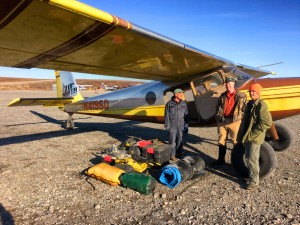
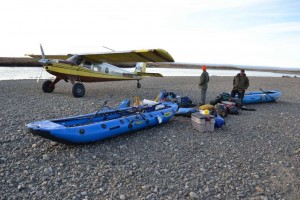
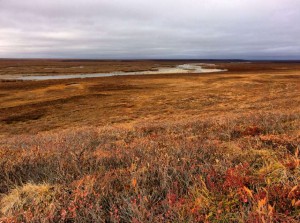
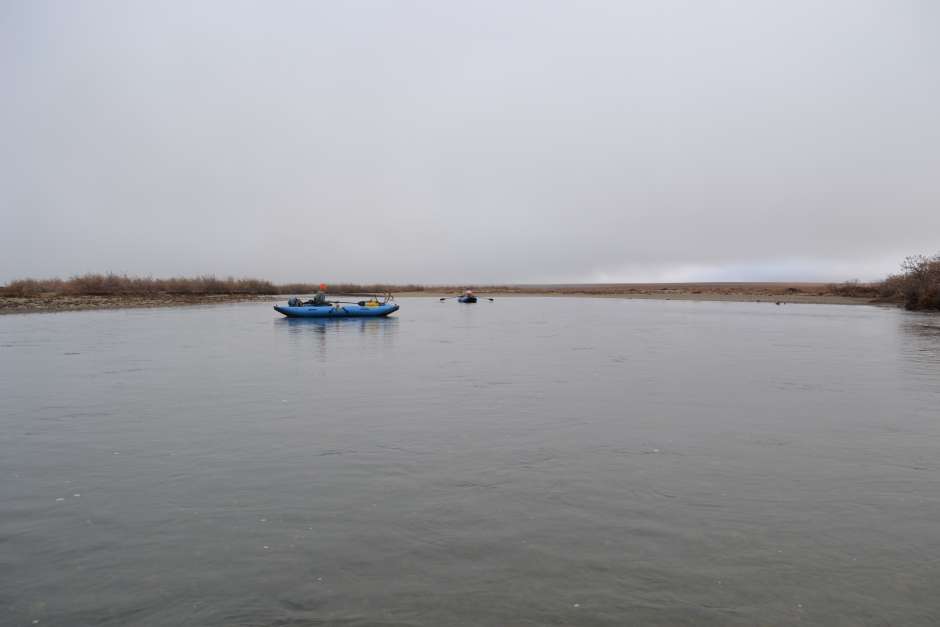
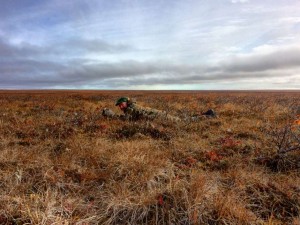
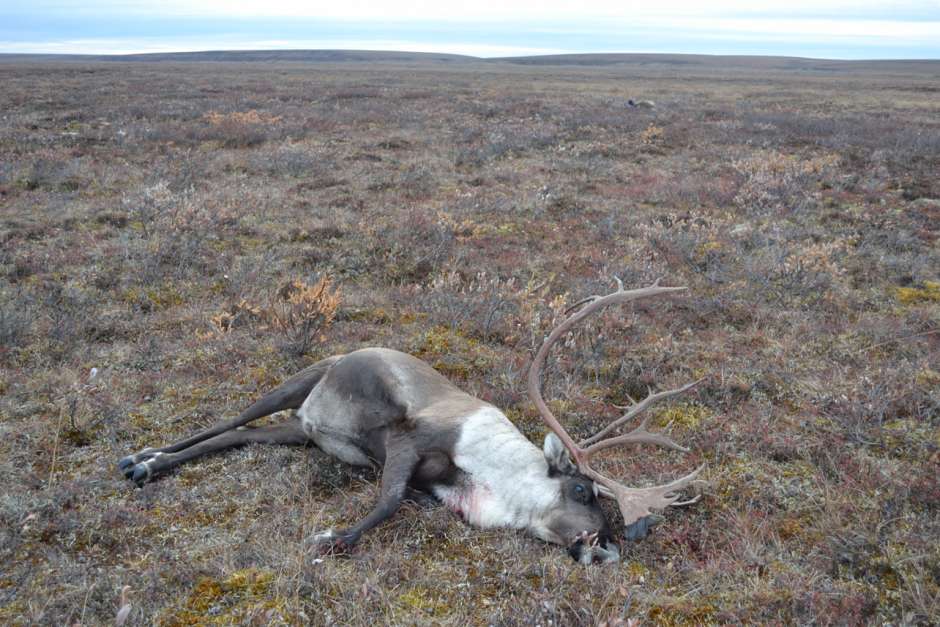
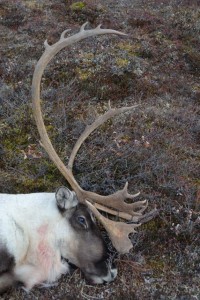
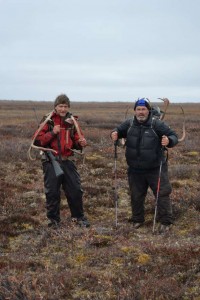
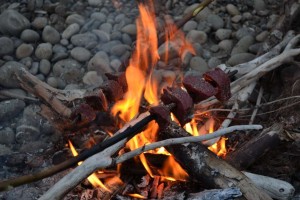
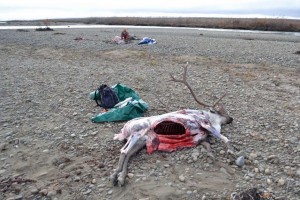
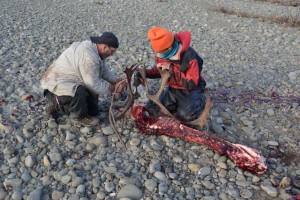
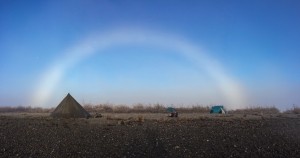
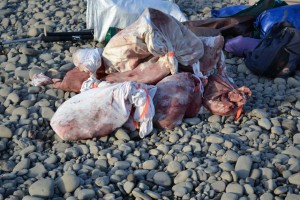
Great story, it sounds you had a fine adventure! I love the picture of the “fogbow” and camp – very cool. I’m actually looking at doing a trip on this same river, flying in with 70 North. Is there any chance that you’d be willing to chat with me about your river trip (what part you floated, river hazards, etc…)? It seems like a pretty special place.
Thanks in advance,
Corey Fisher
Hi, Corey. It was a great trip. My suggestion is to do what we did: Follow the pilot’s recommendation. That’s how we wound up having such an excellent experience (when we’d been aiming for a completely different river and region). He just dropped us where his experience suggested we’d be able to float through caribou. We experienced no river hazards at all. Best, K.
Thanks for the help. I’ve had some good conversations with 70 North and and it seems like its going to be a great experience. Glad to hear you didn’t get into any river hazards, good to know.
Cheers,
Corey